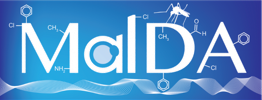Regulatory motifs uncovered among gene expression clusters in Plasmodium falciparum.
Journal:
Molecular and biochemical parasitology, Volume: 153, Issue: 1Abstract:
Control of gene expression is poorly understood in the Plasmodium system, where relatively few homologues to known eukaryotic transcription factors have been uncovered. Recent evidence suggests that the parasite may utilize a combinatorial mode of gene regulation, with multiple cis-acting sequences contributing to overall activity at individual promoters [1]. To further probe this mechanism of control, we first searched for over-represented sequence motifs among gene clusters sharing similar expression profiles in Plasmodium falciparum. More specifically, we applied bioinformatic tools to a previously characterized micro-array data set from drug-treated asexual stage cultures (Gunasekera et al., submitted). Cluster analysis of 600 drug responsive genes identified only a single 5′ motif, GAGAGAA. Two additional 5′ motifs, ACTATAAAGA and TGCAC, were also shared among loci displaying patterns of coordinate expression across varying asexual growth stages. Secondly and most importantly, the functional relevance of each motif was tested in two independent assays-transient transfection and gel-retardation experiments. The GAGAGAA and TGCAC motifs were both active in the former. The GAGAGAA and ACTATAAAGA elements formed specific RNA-protein, but not DNA-protein complexes in gel shift assays, suggesting a key level of control at the RNA level. This is the first report of functionally characterized motifs in P. falciparum that were uncovered following clustering analysis of its asexual stage transcriptome. Together, both the bioinformatic and functional data reported here imply that multiple forms of gene regulation, including post-transcriptional control, may be important in the malarial system.
